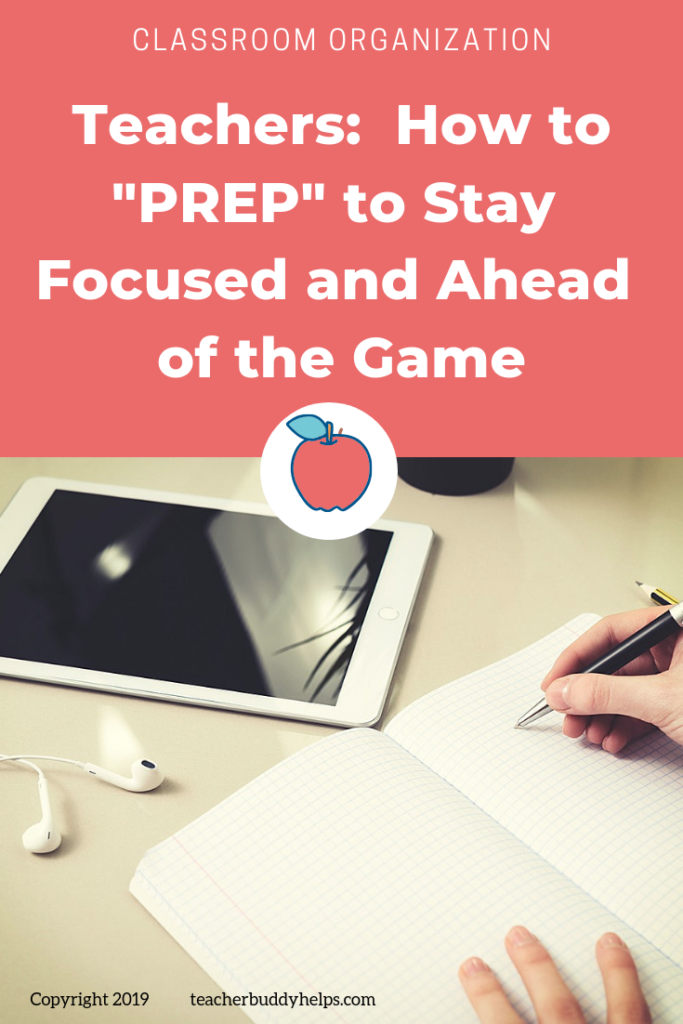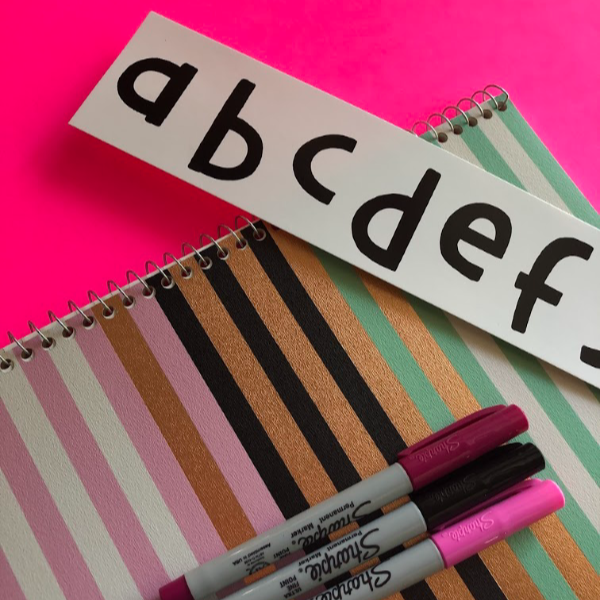Teacher Organization – How to PREPARE and Stay Focused

How do you prepare and stay focused to become the organized teacher you strive to be? Some teachers are fortunate in that they have a built-in “PREP” time either daily or weekly. In other districts, it is an expectation that teachers will prep for their classes when class is not in session.

Most American schools actually have about five and a half to six hours of instructional time. That leaves about an hour each day that teachers should be “prepping” for instruction. OR grading work. AND working on reports. ALSO reviewing data. The “extras” can go on and on, RIGHT!!
I was fortunate enough to work as an Instructional Aide while I was in college. My master teacher was an EXCELLENT teacher who was highly organized. I learned my organizational strategies from her, so “Thank you Ms. Bagomez!”
How to prepare and stay focused; the best way is to Plan a Week Ahead of Time
You see, she always, ALWAYS had everything planned a week ahead of time! When I arrived, she would have work for me, her Instructional Aide, to do prior to taking a group of students to work with. Each task had any necessary instructions listed on the front of the stack and I easily knew what to do.
If you adopt this routine, you are working on the following week’s tasks. The stress is alleviated since you will be READY for that day, and the next day. And what you are working on is coming up in a week of so.
I wrote another post about controlling all the paperwork involved with student work. You can access it here: First Year Teacher Preparation: How Can I Ever Grade All These Papers.
Here are Some Examples
On Monday or Tuesday, I would map out my plan book beyond the “skeleton” (because I did it in the summer before).
You can read more about the “skeleton” part of my plan book in my post entitled: Setting up the Perfect Classroom.
List the TE page numbers. Then the titles, and my “to do list” would be added to as I planned out each lesson; are there pages to xerox off, construction paper that needs cutting, art supplies to get out?
Using Colored Folders
Often, as I was planning, I would begin to organize color coded file folders for each subject area. The folders would contain pages needed to place under the doc-u-cam for instruction, any student pages needed, etc. I would put a sticky note with the day of the week it was for, and the TE page number.
So, for example; I would have a:
- Red folder for Language Arts
- Blue folder for Math
- Yellow folder for Social Studies
- Green folder for Science
And in each folder, everything needed for Monday – Friday is inside, in the correct order (beginning with Monday). So since I was planning for the next week, this week’s work would be in there too.
So next week’s work would go behind this week’s. Or you could have two sets of folders – whatever way works best for you.)
What about Prepping for Kindergarten?
If you teach primary grades and your “prep” includes crafts, you might want to use tubs instead of colored folders. That way things like construction paper, patterns, etc. can fit in with no problem.
If you knew that you had parent volunteers or if you had an Instructional Aide, you could have tasks ready for them to work on ahead of time as well.
One year I had a parent helper who came every Friday (without fail). I put her to work gathering student work from folders.
Then she would staple them all into a packet (or two depending on the thickness) with my cute Teacher form on the top.
As an extra bonus, while she was quietly doing this for me she would have individual students (that I chose) read aloud to her to gain more practice. WIN-WIN !!!
Speaking of being organized and prepared, have you established your classroom routines yet? I have created a FREE “Classroom Routines Checklist” that I am sharing with you all. Just complete the form below with your email address, and I will zip it right over to you.
**
Long-Term Mapping
Another important part of “prepping” ahead is long-term mapping. Sometimes this entailed “backwards mapping” which meant starting at the end. And fitting the content that needs to be taught between now and the ending date. This was especially important as we administered grade level data tests. And also when preparing for the annual standardized tests for national comparison.
I’ve written another article on Long-term planning that explains everything in much more detail. You can access it here.
The Instructional Benefits of Long-Term Planning? Do you know what they are?
In addition to regular planning, you should also plan for “Response to Intervention (RtI) groups. These need to be regularly scheduled throughout the week, daily is the ideal scenario.

What Kind of RtI Independent Work is Needed?
To me, the most difficult part of planning for RtI was figuring out what the other students would be doing. I wanted to be sure that the work the students were doing was meaningful. And it needed to be work they could complete independently without any assistance.
I learned this the hard way during my first couple years teaching. Periodically, I would assign something that many students needed help with. But I was interrupted from the small group by students needing help. I learned what was truly “independent” work and what wasn’t.
This may take a few years for you also to gain the knowledge of what is truly “independent” work for that particular age of students.
Over-Prepping, another “how to prepare and stay focused” strategy!
Toward the beginning of my teaching career, I tended to over prepare (put too much content in the allotted time period). I got better at calculating this as time went on. For this reason, I HIGHLY RECOMMEND WRITING IN YOUR LESSON PLAN BOOK IN PENCIL.
As the week went on, I circled what wasn’t completed (or what I didn’t even get to yet) and drew arrows to the next day. Most content was moved down to another day, but some was eliminated if it was extra “suggested” content from the publisher.
In my opinion, it’s better to be over prepared than under prepared.
Finding Needed Supplies
Sometimes, the Teacher’s Edition would suggest an activity that required certain items (manipulatives) that you (and your school) didn’t have. Instead of completely skipping that activity, consider an alternate way to present that activity, or an alternate item that you can use.
For example, if your TE asks for Unifix cubes for GROUPS OF TEN. If you don’t have those, consider asking the Kindergarten team if you can borrow some. Or consider using beans and small cups (both can be purchased easily and inexpensively at the local supermarket).
OR you can send home a note a week before the lesson BECAUSE YOU ARE PLANNING AHEAD!! asking parents to send a bag full of beans and small cups for their child.
Side Note Here: You will have to get some beans yourself because there will inevitably be some students who don’t bring theirs.
MID-TERM Planning to prepare and stay focused.
I’m calling this next part “mid-term” planning because I don’t want you to confuse it with long-term planning. This is a new phrase I just thought up so you would think, about what is coming up in a month or two.
The reason you should do this periodically, is because sometimes you can spot things on sale NOW for something you will need in about 6 weeks (let’s just say). It would be SUPER SMART to get it now while it’s on sale.
For example, one year when I was teaching sixth grade we were approaching a Social Studies unit where we were learning about the Ancient Egyptians. I decided that I wanted to have them learn about how the Egyptians mummified the bodies and then wrapped them for burial.
After doing some research, I found a way to replicate the process using “cornish game hens” soaked in rock salt for about two-three weeks and then wrapped in strips of old cloth soaked in liquid starch to make the mummies.
As you can imagine, this took a lot of prior planning!
I found the game hens on sale a month ahead of time, but got them while on sale.
I had them work in groups of three for this (mainly so I wouldn’t have as many “game hens” to purchase. Then we had to complete the rock salt part about a month before the cloth part.
I asked students to bring in old linens or shirts. One afternoon we spent about a half hour cutting strips of cloth.
(I put on some of their music and they had a good time).
The lesson turned out well. I wish I still had pictures of it.
(In case you are wondering, I took the “game hens” in the rock salt bags home. For three weeks they soaked in the salt). And then I brought them back for the wrapping part.
Do you see how this lesson took a LOT OF PRE-PLANNING? Now you understand how to prepare and stay focused!
So, my CHALLENGE TO YOU IS THIS. Make a pledge to yourself to start the next school year off using this method. Plan a week ahead of time for the entire school year. Believe me, you will never regret getting into this habit.
I hope this post has given you numerous ideas about staying focused. And also about preparing ahead of time for your lessons and activities.
Just in case you’d like to read more about getting organized, here is an article from another website, “Teach 4 the Heart” called:
5 Easy Classroom Organization Ideas.
Let me know what other tips you want to hear about from a veteran teacher!
Your Teacher Buddy!






